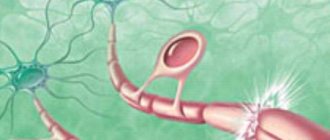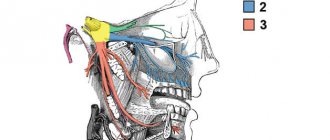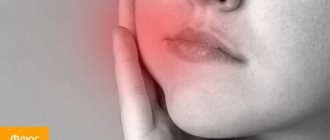Every day people go to the dentist with aching pain in the elements of the dental system. The syndrome can develop due to damage to enamel, dentin, and pulp. Based on the nature of the localization, pain sensations can be pulsating, aching, shooting in nature, temporary or long-lasting. Most often, pain is observed in the evening and at night. In this case, you must immediately contact a specialized specialist for diagnosis and prescribing appropriate therapy, followed by removal of the tooth nerve. Self-treatment at home can aggravate the situation and contribute to the development of serious complications.
What is a tooth nerve
Each element of the dentition consists of hard and soft tissues. The visible part is represented by dense enamel. Then comes the dentin and only then the pulp chamber, which has many root tubules and nerve endings. The number of tubules is equal to the number of roots in canines and molars. Nervous tissue plays a vital role in the formation and growth of teeth. It is responsible for nutrition, delivering the necessary nutrients to the cavity to maintain their performance. You can see what the nerve of a tooth looks like on the Internet.
With the development of carious processes, damage to the dentin and pulp chamber occurs. The dentist most often diagnoses pulpitis or periodontitis. The patient may experience severe piercing pain. The cause may be general hypothermia of the body, the development of an infection in the oral cavity, mechanical damage to the coronal part, or an advanced carious process. Most often, the patient cannot understand which element of the dental system is bothering him. He only indicates the location of the pain, and the dentist determines the cause.
Stages of depulpation
Modern techniques make it possible to remove the dental nerve in just one visit to the dental office. The process of depulpation begins in the same way as in the treatment of caries.
- Anesthesia. The doctor treats the soft tissue with a freezing agent, then injects an anesthetic and waits about 15 minutes.
- Preparation for pulp removal. The affected tissue is removed to provide access to the dental nerve.
- Depulpation. To remove the pulp, special instruments are used to quickly and painlessly remove it from the root canal and crown part of the tooth.
- Filling. Safe composites, dental cement and other materials are used for filling. In case of difficult removal, the doctor can place a temporary filling, and at a follow-up appointment, if there are no complications, he will install a permanent one.
Removal can be complete or partial. The second method is used in case of an inflammatory process that has affected only the coronal part of the dental nerve. In this case, after anesthesia and removal of dead tissue, only the affected coronal pulp is cut off, while the root pulp remains completely.
Most often, this technique is used in the treatment of teeth in childhood, when there is a need to preserve the root part, since it is the part that is responsible for the correct formation of the root system.
Why does a tooth need a nerve?
The main function of nerve endings is sensory perception. With the rapid development of the pathological process, a pain reaction occurs, which signals tissue damage. Many people ask why there is a nerve in a tooth. In reality, it plays an important role and performs the following functions:
- Sensory. Signals the presence of development of an anomalous process.
- Nutritious. Provides nutrition to soft and hard tooth tissues.
- Immune. Plays an important protective role.
In addition, nerve endings play an important role in the mineralization of enamel and dentin. Why there are nerves in a tooth and what their role is, you can find out from our dentists at the Alpha Dent clinic. They are always ready to clearly demonstrate and tell everything so that the patient has a complete picture of why pain occurs and how to prevent the spread of the inflammatory process. Our clinic specialists are always ready to provide free advice and provide the necessary assistance.
Is it possible to cure such a tooth?
You can cure, but you cannot resurrect. The dentist will remove all affected tissues, nerves, root canals, expand them, clean them and treat them with an antiseptic, and then seal them hermetically so that infection does not enter from outside. The crown, if more than half of it is preserved, will be restored with a filling. For more severe lesions, an artificial crown will be installed. However, in case of extensive inflammation, the tooth can be removed and replaced with a prosthesis - an implant.
A “dead” tooth must be shown to a doctor, otherwise there is a risk of complications from the infection, which will develop into gumboil, osteomyelitis. A cured tooth can perform its function fully, but it can withstand the load worse, so its service life is significantly lower than that of “living” teeth.
Symptoms of the lesion
The cause of the formation of a pathological process can be carious lesions, inflammation of soft tissues, or mechanical damage to the teeth. The main symptoms include severe aching pain that can radiate to the temporal tissue. You may experience bad breath. The painful area may react acutely to hot and cold foods. With the development of the pathological process, swelling, inflammation of the pulp chamber, and the formation of pus may be observed over the course of several days.
Many patients often wonder whether the nerve in a tooth can die on its own. Yes, maybe, if the destructive process has gone far enough. The main symptom will be a sudden cessation of pain. However, without timely dental intervention, the infection can spread further and affect the trigeminal nerve, leading to trigeminal neuralgia. The consequence will be impaired facial expressions, facial distortion and other anomalies.
How to kill the pulp in dentistry
A dental procedure is performed under anesthesia, regardless of the nature and scope of the work. The specialist knows why there are nerves in teeth, so he selects an anesthetic taking into account the anatomical features, the patient’s possible allergic reaction and individual wishes. The depulpation process is as follows:
- Removal of dentin and enamel with anesthesia. The procedure is carried out using air cooling technology.
- Placing a special paste that allows you to kill the nerve of the tooth, both the canine and the molar. Today, modern pastes are used to devitalize nerve endings.
- Installation of a temporary filling.
- Removal of temporary filling, opening of the pulp chamber, extraction of nerve endings.
- Canal cleaning, disinfection, filling.
At the final stage, a control x-ray is taken, where the patient and the doctor can see how the canals were sealed. After the procedure, the question may arise about how to relieve toothache even though the nerve has already been removed. For this you can use drugs such as Ibuprofen, Pentalgin, Nimesil. It is recommended to use only those products prescribed by the dentist. After treatment for pulpitis, pain may be observed for a week.
How to calm the tooth nerve yourself
In some cases, it may not be possible to visit a dentist in the near future. For example, if you are far from the city, where it is impossible to find a specialized clinic. Then you can use traditional medicine recipes, use a soda-salt solution. To do this, you will need to dilute baking soda and salt in warm water and rinse your mouth. If soda and salt are not available, you can use 3 percent hydrogen peroxide, which is diluted with water in a ratio of 2:1. Then the swab is moistened in this solution and applied to the painful area of the dental system.
We looked at how to calm the dental nerve at home if you are unable to visit a dentist. Additionally, you can use herbal decoctions based on mint or chamomile. In some cases, clove essential oil is used. It is enough to drop it on a cotton swab and apply it to the painful area. It has good anti-inflammatory and antiseptic effects. However, if these funds are not at hand, and you do not know how to numb the tooth nerve that is inflamed, call the dentist on duty. It is better, of course, to immediately go to the doctor, since an independent decision can lead to the development of dangerous complications.
Is it possible to kill a nerve yourself?
Many people try to remove the nerve endings in the tooth on their own. When a pathological process develops, the help of a specialist is required, otherwise complications may occur. There are various techniques that show how to kill the nerve of a tooth at home. All of them are for informational purposes only. Vinegar can be used for killing; a piece of cotton wool is treated with vinegar essence and applied to the tooth. It is important to note that the essence can completely destroy enamel and dentin and lead to irreversible consequences.
We looked at what would happen if you removed the nerve in a tooth yourself. This can lead to complete destruction of an element of the dentition. The patient will lose a tooth and may subsequently require the installation of an implant, crown, or other suitable orthodontic structure.
What can lead to the need to remove a “dead” tooth:
- damage to the tooth root by caries;
- the occurrence of longitudinal fractures and root cracks (below the gum level);
- the presence of a cyst or granuloma on the root of the tooth, inflammation of the tissues surrounding the tooth, the treatment of which is not possible.
There are several rules that patients can follow to prolong the life of their teeth:
- cover the tooth with a ceramic inlay or crown;
- visit the dentist once every 6 months for a check-up, hygienic cleaning and, if necessary, a control X-ray of the tooth;
- do not chew hard food (nuts, seeds, crackers, etc.);
- Avoid temperature changes when eating (for example, hot coffee with cold ice cream).
As we see, a patient can do a lot for his health. But in order for the tooth to last longer, it is much more important to choose a specialized clinic that uses modern technologies, high-quality equipment and materials. An experienced and knowledgeable doctor will ensure the vital activity of a pulpless tooth for a long time.
Practical recommendations after visiting the dentist
If depulpation is performed correctly, pain may be observed. The pain may persist for several days. In this case, you can use painkillers prescribed by your dentist. However, if the pain does not stop for a week or more, you should immediately consult a doctor.
In this article, we learned why there are nerve endings in teeth, what important function they perform, and how to act in case of severe pain. In addition, you can learn more about why nerves are needed in teeth on specialized medical web resources, where dentists describe and explain everything in detail.
Alpha Dent specialists provide high-quality dental services. The clinic uses advanced equipment and innovative drugs, which ensures impeccable quality of therapy. Dentists will be happy to tell you how the nerves are located in a person’s teeth and what treatment is needed to achieve the desired result.
How long does a tooth hurt after nerve removal?
It should be noted that pain for several days after removing the nerve and filling the canals is a natural reaction of the body to the intervention. Dentists call this condition post-filling pain. During the procedure of pulp extraction and canal treatment, microtrauma to surrounding tissues is inevitable, so after the anesthesia wears off, the patient may experience discomfort. Normally, they are easily relieved with analgesics and gradually disappear.
The following symptoms indicate complications:
- 5-7 days after removal of the nerve, the tooth still hurts;
- the pain is strong and sharp;
- painkillers do not relieve pain;
- gum inflammation;
- the temperature has risen;
- headache;
- the pain spread to other teeth.
In this case, you should immediately consult a doctor so that he can do an x-ray or CT scan and find out the cause of the complication.









